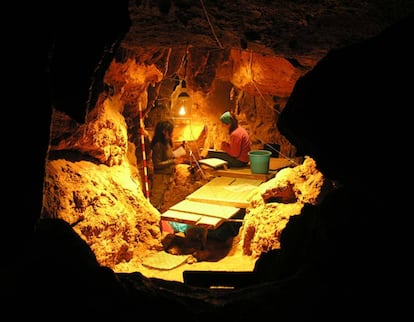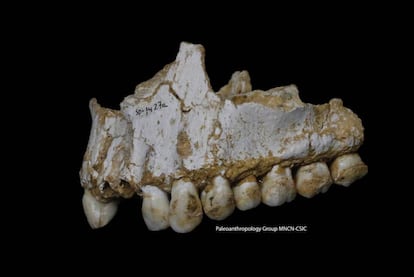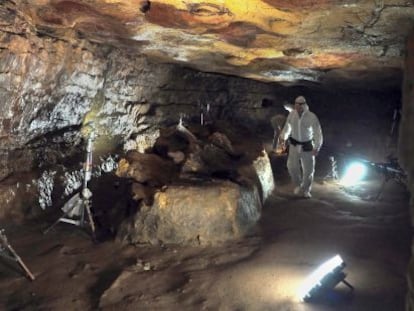Neanderthals had their own kind of ‘aspirin’
Dental records from Spanish cave suggest they chewed poplar bark, a source of salicylic acid
What if the Neanderthals had not gone extinct 40,000 years ago in their last redoubt in the Iberian peninsula? Modern humans – Homo sapiens – would no longer be an exception in the animal world. We would no longer be alone.

“Perhaps we wouldn’t have had to invent gods to explain ourselves away. Perhaps we could have even talked and reasoned with them. Perhaps we would not have caged them, and might have granted them human rights and allowed them to vote in elections,” reasoned Spanish geneticist Carles Lalueza-Fox in his 2013 book Palabras en el tiempo (or Words in time).
On Wednesday, the science journal Nature published a study co-authored by Lalueza-Fox that suggests this extinct human species had developed its own medicine cabinet to handle pain and disease.
Sex is the best way to pass on pathogens
Carles Lalueza-Fox, geneticist
This is what emerges from an analysis of calcified dental plaque from two individuals who once lived in the northern Spanish cave of El Sidrón, two others from the Belgian site of Spy, and a fifth Neanderthal from the Italian cave of Breuil.
“Evidence for self-medication was detected in an El Sidrón Neanderthal with a dental abscess and a chronic gastrointestinal pathogen,” reads the study abstract.
Ancient DNA from this individual’s dental plaque suggests that he chewed poplar bark, which is a natural source of salicylic acid, the analgesic ingredient in aspirin. “This bark has no nutritional value, so why would he chew it if not to relieve the pain?” wondered Lalueza-Fox, of the Evolutionary Biology Institute in Barcelona, at a presentation of the study.
The Neanderthal also consumed Penicillium, a fungus with antibiotic properties.
These results back the findings of an earlier 2012 study, which concluded that the Neanderthals of El Sidrón used plants like chamomile, which helps with digestion, and Achillea, which has anti-inflammatory properties.
The British prehistorian Karen Hardy, of Barcelona’s Autonomous University, signed both papers. “All of the world’s animals self-medicate. Dogs, for instance, eat grass to induce vomiting. To me , the surprising thing would be for Neanderthals not to self-medicate,” she said.

Recent research has dispelled the cartoonish notion of Neanderthals as subhuman creatures. Members of the species adorned themselves with showy feathers, possessed praiseworthy technology, used fire to cook, buried their dead and had sex with modern humans over 100,000 years ago.
“The Neanderthals were intelligent, and they possessed an ecological knowledge that we have lost,” said Hardy.
María Martinón Torres, a paleoanthropologist at London University College, notes how the study shows that Belgian Neanderthals had a meat-based diet, while the Spanish ones were more vegetarian. “That diversity portrays the Neanderthals as a flexible species, able to exploit different resources depending on circumstance and availability,” she notes.
This bark has no nutritional value, so why would he chew it if not to relieve the pain?
Carles Lalueza-Fox, geneticist
This researcher is aware that a British anthropologist named Chris Stringer came up with an alternative theory in 2013: that these non-food plants were found in Neanderthal dental records due to their own consumption of herbivore stomach contents.
But Martinón Torres notes that the indications of salicylic acid and natural antibiotic consumption only show up in a Neanderthal with a painful dental abscess, “which seems like more than just a happy coincidence.”
The new study has obtained a nearly complete genome of Methanobrevibacter oralis, the oldest draft microbial genome generated to date, at around 48,000 years old. Its analysis indicates that Neanderthals and modern humans shared oral pathogens until 180,000 years ago at the very least, after separating into two species 600,000 years ago.
“Sex is the best way to pass on pathogens,” explained Lalueza-Fox.
The cave of El Sidrón, in the northern Spanish region of Asturias, was discovered in 1994. Since then, it has produced a treasure trove of 2,500 bone remains from at least 13 Neanderthal individuals, both male and female. Around 49,000 years ago, in what appears to be an act of survival cannibalism, someone cracked open their skulls in order to eat their brains.
English version by Susana Urra.
Tu suscripción se está usando en otro dispositivo
¿Quieres añadir otro usuario a tu suscripción?
Si continúas leyendo en este dispositivo, no se podrá leer en el otro.
FlechaTu suscripción se está usando en otro dispositivo y solo puedes acceder a EL PAÍS desde un dispositivo a la vez.
Si quieres compartir tu cuenta, cambia tu suscripción a la modalidad Premium, así podrás añadir otro usuario. Cada uno accederá con su propia cuenta de email, lo que os permitirá personalizar vuestra experiencia en EL PAÍS.
¿Tienes una suscripción de empresa? Accede aquí para contratar más cuentas.
En el caso de no saber quién está usando tu cuenta, te recomendamos cambiar tu contraseña aquí.
Si decides continuar compartiendo tu cuenta, este mensaje se mostrará en tu dispositivo y en el de la otra persona que está usando tu cuenta de forma indefinida, afectando a tu experiencia de lectura. Puedes consultar aquí los términos y condiciones de la suscripción digital.
More information
Últimas noticias
Most viewed
- Why we lost the habit of sleeping in two segments and how that changed our sense of time
- Trump’s obsession with putting his name on everything is unprecedented in the United States
- Pablo Escobar’s hippos: A serious environmental problem, 40 years on
- The Florida Keys tourist paradise is besieged by immigration agents: ‘We’ve never seen anything like this’
- Charles Dubouloz, mountaineering star, retires at 36 with a farewell tour inspired by Walter Bonatti











































